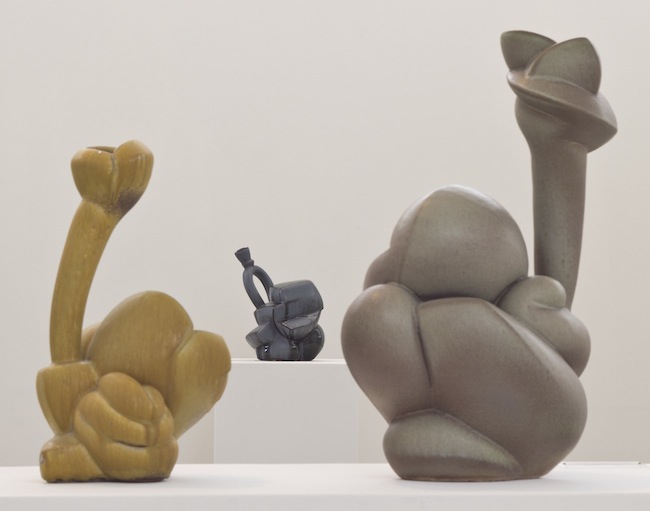This traveling retrospective exhibition, now at its final destination the Daum Museum (Sedalia, MO February 1, 2014 – May 25, 2014) traces Chris Gustin’s evolution as a ceramist during a career that has spanned 40 years. The 80 works in the exhibition range from diminutive tea bowls to sculptural forms measuring up to four-feet high. There are examples from almost every series of work the artist has made, with pieces from numerous public and private collections from throughout the country, as well as Gustin’s own archives.
Gustin (b. 1952) is one of the leading ceramists of his generation. He received a BFA from the Kansas City Art Institute and an MFA from Alfred University. He is an emeritus professor of art at the University of Massachusetts, Dartmouth. Gustin has had more than 40 solo exhibitions at leading institutions and galleries throughout the country and abroad. His work is in numerous collections, including the Renwick Gallery, Washington, DC; the Los Angeles County Museum of Art; the Museum of Art and Design, New York City; the World Ceramic Exposition Foundation, Icheon, Korea; and Daum Museum of Contemporary Art.
Gustin’s work began with a production of functional, utilitarian wares and shifted gradually to the sensuous, monumental sculptural vessels of the present. He is well regarded for his biomorphic volumes and his dedicated exploration of the vessel. Throughout his career, he has experimented with the formal binaries of inside and outside, glaze and surface. He is also respected for his accomplishments with wood-fired anagama kilns.
What makes his trajectory so fascinating is that the work has grown both ever more subtle and powerful. The early work is pugnaciously assertive, erupting volumes within a singe form. Often he used powerful glaze colors with their sandblasted surfaces (an inheritance from his professor Robert Turner). From the outset he was a standout in the field with work that carried his signature in its energy.
As one traces the show one witnesses a reductive process in which less complex forms become more. His newest work has that quality I most admire in pots. It is called breathing. This is the visual feeling of the wall of the pot gently moving out in the world and then back into its interior volume. It is one of the magical things that masterfully-formed handmade pots do that is unique. And this quality is abetted by the hypnotic glazes, also a tad undersold, an extremely powerful coulee of velvet texture and muted color moving downward slowly with a zen-like calm.
It is one thing to be a young Turk during the heyday of the late 20th century ceramics movement, quite another to be a leading player in the 21st century. I have always felt that one cannot make a true judgment about an artist until after their mid-forties. This is where most careers either implode or explode. Gustin has passed safely through this threshold, making the best art of his career and among the finest pots being produced today.
A superb 160 page book accompanies the exhibition, Chris Gustin Masterworks in Clay, published in 2012 by the Fulller Craft Museum, Brockton, MA. A bonus in this publication is the essay by Ed Lebow who writes all too rarely, but always brilliantly, on ceramics.
Garth Clark is the Chief Editor of CFile.
Above image: Installation view of Chris Gustin’s work on display at the Daum Museum.
Any thoughts about this post? Share yours in the comment box below.

Chris Gustin, Untitled, 2008, stoneware, 36 x 21 x 19 inches (detail view)

Chris Gustin, Untitled, 1990, stoneware teapot, 13 x 12 x 6 inches

Chris Gustin, Untitled, 1980, stoneware platter, 25 x 25 inches

Chris Gustin, Untitled, 2005, stoneware, 35 x 25 x 24 inches and Chris Gustin, Untitled, 2008, stoneware, 38 x 20 x 22 inches

Chris Gustin, Untitled, 2008, stoneware, 44 x 27 x 23 inches and Chris Gustin, Untitled, 2008, stoneware, 48 x 24 x 26 inches

Chris Gustin, Untitled, 1995, stoneware, 16 x 9 x 10 inches

Chris Gustin, Untitled, 1999, stoneware, 35 x 32 x 35 inches

Chris Gustin, Untitled, 2008, stoneware, 36 x 21 x 19 inches

Chris Gustin, Untitled, 2012, stoneware, 42 x 24 x 22 inches


Installation views of Chris Gustin’s work on display at the Daum Museum.
Visit the Daum Musuem of Contemporary Art

Thanks for sharing your info. I really appreciate your efforts and I
will be waiting for your next post thank you once again.
For me a discovery!
Thank you!
AM
Pots…..Big and beautiful, clay and glaze. It’s not edgy, doesn’t require a big artist statement or extravagant title, “untitled” is just fine. Impeccably crafted and executed , the scale shows his total commitment and skill. He’s done all the work. Please make more. Thanks for sharing. N